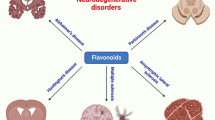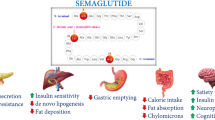Abstract
Diabetes mellitus (DM) is characterized by hyperglycemia due to insulin inactivity or insufficiency with increasing risk of developing specific complications, including retinopathy, nephropathy, neuropathy, and atherosclerosis. The aim of the present study is to evaluate the efficacy of coenzyme Q10 (CoQ10), niacin, as well as their combination in ameliorating brain disorders associated with streptozotocin (STZ)-induced diabetes in rats. Glibenclamide, a reference diabetic drug, and donepezil, an acetylcholine inhibitor drug, were also evaluated. Diabetes was induced by single intraperitoneal injection of STZ (60 mg/kg body weight (b.wt)). One-month diabetic rats were treated with the selected drugs daily for another two consecutive weeks. The evaluation was done through the estimation of the levels of blood glucose, serum insulin, and oxidative stress markers: malondialdehyde (MDA), superoxide dismutase (SOD), and glutathione (GSH); neurotransmitters: acetylcholine (Ach) and dopamine (DA); vasoconstrictor indices: intercellular adhesion molecule-1 (ICAM-1), vascular cell adhesion molecule-1(VCAM-1), and angiotensin II (Ang II); and apoptosis markers: tumor necrosis factor-α (TNF-α) and caspase-3 as well as the histopathological picture of the cerebellum region of the brain. The results revealed that the combination of niacin and CoQ10 improved most of the measured parameters with variable degrees. In conclusion, niacin and CoQ10 are promising dietary supplements in the management of diabetic encephalopathy.






Similar content being viewed by others
References
Northam E, Rankins D, Cameron FJ (2006) Therapy insight: the impact of type 1 diabetes on brain development and function. Nat Clin Pract Neurol 2:78–86
Northam EA, Rankins D, Lin A, Wellard RM, Pell GS, Finch SJ (2009) Central nervous system functions in youth with type 1 diabetes 12 years after disease onset. Diabetes Care 32:445–450
Sima AAF, Kamiya H, Lia ZG (2004) Insulin C-peptide, hyperglycemia, and central nervous system complications in diabetes. Eur J Pharmacol 490:187–197
Strachan MWJ, Frier BM, Deary IJ (2003) Type 2 diabetes and cognitive impairment. Diabet Med 20:1–2
Cukierman T, Gerstein HC, Williamson JD (2005) Cognitive decline and dementia in diabetes—systematic overview of prospective observational studies. J Diabetes 48:12–19
Arvanitakis Z, Wilson RS, Bienias JL, Evans DA, Bennett DA (2004) Diabetes mellitus and risk of Alzheimer disease and decline in cognitive function. Arch Neurol 61:661–666
McCall AL (2004) Cerebral glucose metabolism in diabetes mellitus. Eur J Pharmacol 490:147–158
Knopman DS, Boland LL, Mosley T, Howard G, Liao D, Szklo M (2001) Cardiovascular risk factors and cognitive decline in middle-aged adults. Neurology 56:42–48
Röosen P, Nawroth PP, King G, Möller W, Tritschler HJ, Packer L (2001) The role of oxidative stress in the onset and progression of diabetes and its complications: a summary of a congress series sponsored by UNESCO-MCBN, the American Diabetes Association, and the German Diabetes Society. Diabetes Metab Res Rev 17:189–212
Vlassara H (1997) Recent progress in advanced glycation end products and diabetic complications. Diabetes 46:S19–S37
Hoyer S (1998) Is sporadic Alzheimer disease the brain type of non-insulin dependent diabetes mellitus? A challenging hypothesis. J Neural Transm 105:412–422
Ashokkumar N, Mohan K, Ramkumar PL (2007) Modulatory effect of N-benzoyl-D-phenylalanine on cholinesterases in rat retinas of neonatal streptozotocin diabetic rats. World J Med Sci 2:39–45
O’Connor JC, Johnson DR, Freund GG (2006) Psychoneuroimmune implications of type 2 diabetes. Neurol Clin 24:539–559
Kierdorf K, Wang Y, Neumann H (2010) Immune-mediated CNS damage. Results Probl Cell Differ 51:173–196
Villalba JM, Parrado C, Santos-Gonzalez M, Alcain FJ (2010) Therapeutic use of coenzyme Q10 and coenzyme Q10-related compounds and formulations. Expert Opin Investig Drugs 19:535–554
Littarru GP, Tiano L, Belardinelli R, Watts GF (2011) Coenzyme Q (10), endothelial function, and cardiovascular disease. Biofactors 37:366–373
Vincent AM, Edwards JL, Sadidi M, Feldman EL (2008) The antioxidant response as a drug target in diabetic neuropathy. Curr Drug Targets 9:94–100
Elam MB (2000) Effect of niacin on lipid and lipoprotein levels and glycemic control in patients with diabetes and peripheral arterial disease: the ADMIT study: a randomized trial. Arterial Disease Multiple Intervention Trial. JAMA 284:1263–1270
Guyton JR (2007) Niacin in cardiovascular prevention: mechanisms, efficacy, and safety. Curr Opin Lipidol 18:415–420
Rosenson RS (2003) Antiatherothrombotic effects of nicotinic acid. Atherosclerosis 171:87–96
Chapman MJ (2004) Raising high-density lipoprotein cholesterol with reduction of cardiovascular risk: the role of nicotinic acid—a position paper developed by the European Consensus Panel on HDL-C. Curr Med Res Opin 20:1253–1268
Chen J (2007) Niaspan increases angiogenesis and improves functional recovery after stroke. Ann Neurol 62:49–58
Ye X, Chopp M, Cui X, Zacharek A, Cui Y, Yan T, Shehadah A, Roberts C et al (2011) Niaspan enhances vascular remodeling after stroke in type 1 diabetic rats. Exp Neurol 232:299–308
Serrano-Martín X, Payares G, Mendoza-León A (2006) Glibenclamide, a blocker of K+(ATP) channels, shows antileishmanial activity in experimental murine cutaneous leishmaniasis. Antimicrob Agents Chemother 50:4214–4216
Birks J, Harvey RJ (2006) Birks, Jacqueline (ed) Donepezil for dementia due to Alzheimer’s disease. Cochrane Database Syst Rev 1: CD001190
Steele LS, Glazier RH (1999) Is donepezil effective for treating Alzheimer’s disease? Can Fam Physician 45:917–919
Noetzli M, Eap CB (2013) Pharmacodynamic, pharmacokinetic and pharmacogenetic aspects of drugs used in the treatment of Alzheimer’s disease. Clin Pharmacokinet 52:225–241
Bhutada P, Mundhada Y, Bansod K, Bhutada C, Tawari S, Dixit P (2010) Ameliorative effect of quercetin on memory dysfunction in streptozotocin-induced diabetic rats. Neurobiol Learn Mem 94:293–302
Coldiron AD, Sanders RA, Watkins JB (2002) Effects of combined quercetin and coenzyme Q(10) treatment on oxidative stress in normal and diabetic rats. J Biochem Mol Toxicol 16:197–202
Yan T, Chopp M, Ye X, Liu Z, Zacharek A, Cui Y, Roberts C, Buller B et al (2012) Niaspan increases axonal remodeling after stroke in type 1 diabetes rats. Neurobiol Dis 46:157–164
Cheng D, Liang B, Li Y (2013) Antihyperglycemic effect of Ginkgo biloba extract in streptozotocin-induced diabetes in rats. Biomed Res Int 2013:162724
Sonkusare S, Srinivasan K, Kaul C, Ramarao P (2005) Effect of donepezil and lercanidipine on memory impairment induced by intracerebroventricular streptozotocin in rats. Life Sci 77:1–14
Buege JA, Aust SD (1978) Microsomal lipid peroxidation. Methods Enzymol 52:302–310
Nishikimi M, Rae NA, Yagi K (1972) The occurrence of superoxide anion in the action of reduced phenazine methosulphate and molecular oxygen. Biochem Biophys Res Commun 46:849–853
Moron MS, Depierre JW, Mannervik B (1979) Level of glutathione, glutathione reductase and glutathione-S-transferase activities in rat lung and liver. Biochim Biophys Acta 582:67–78
Bancroft J, Stevens A (1996) Theory and practice of histological techniques, 4th edn. Churchil Livingstone, Edinburgh
Akbarzadeh A, Norouzian D, Mehrabi MR, Jamshidi SH, Farhangi A, Allah Verdi A, Mofidian SMA, Lame Rad B (2007) Induction of diabetes by streptozotocin in rats. Indian J Clin Biochem 22:60–64
Hussein J, Abo El-Matty D, El-Khayat Z, Abd El-Latif Y (2012) Brain neurotransmitters in diabetic rats treated with coenzyme Q10. Int J Pharm Pharm Sci 4:554–556
Modi KP, Vishwakarma SL, Goyal RK, Bhatt PA (2006) Beneficial effects of coenzyme Q10 in streptozotocin-induced type I diabetic rats. Iran J Pharmacol Ther 5:61–65
Maiese K, Chong ZZ, Hou J, Shang YC (2009) The vitamin nicotinamide: translating nutrition into clinical care. Molecules 14:3446–3485
Olmos PR, Hodgson MI, Maiz A, Manrique M, De Valdes MD, Foncea R, Acosta AM, Emmerich MV et al (2006) Nicotinamide protected first-phase insulin response (FPIR) and prevented clinical disease in first-degree relatives of type-1 diabetics. Diabetes Res Clin Pract 71:320–333
Cutuli D, De Bartolo P, Caporali P, Tartaglione AM, Oddi D, D’Amato FR, Nobili A, D’Amelio M et al (2013) Neuroprotective effects of donepezil against cholinergic depletion. Alzheimers Res Ther 5:50
Gallego M, Setién R, Izquierdo MJ, Casis O, Casis E (2003) Diabetes-induced biochemical changes in central and peripheral catecholaminergic systems. Physiol Res 52:735–741
Ezzeldin E, Souror WAH, El-Nahhas T, Soudi ANMM, Shahat AA (2014) Biochemical and neurotransmitters changes associated with tramadol in streptozotocin-induced diabetes in rats. Bio Med Res Internat 2014
Wadsworth TL, Bishop JA, Pappu AS, Woltjer RL, Quinn JF (2010) Evaluation of coenzyme Q as an antioxidant strategy for Alzheimer’s disease. J Alzheimers Dis 14:225–234
Abdel-Salam OM, Salem NA, Hussein JS (2011) Effect of aspartame on oxidative stress and monoamine neurotransmitter levels in lipopolysaccharide-treated mice. Neurotoxicology 11:9264–9269
Xu R, Yang R, Hu H, Xi Q, Hui Wan H, Wu Y (2013) Diabetes alters the expression of partial vasoactivators in cerebral vascular disease susceptible regions of the diabetic rat. Diabetol Metab Syndr 5:63
Pastore L, Tessitore A, Martinotti S, Toniato E, Alesse E, Bravi MC, Ferri C, Desideri G et al (1999) Angiotensin II stimulates intercellular adhesion molecule-1 (ICAM-1) expression by human vascular endothelial cells and increases soluble ICAM-1 release in vivo. Circulation 100:1646–1652
Tummala PD, Chen XL, Sundell CL, Laursen JB, Hammes CP, Alexander RW, Harrison DG, Medford RM (1999) Angiotensin II induces vascular cell adhesion molecule-1 expression in rat vasculature. A potential link between the renin-angiotensin system and atherosclerosis. Circulation 100:1223–1229
Jing L, Wang JG, Zhang JZ, Cao CX, Chang Y, Dong JD, Guo FY, Li PA (2014) Upregulation of ICAM-1 in diabetic rats after transient forebrain ischemia and reperfusion injury. J Inflamm 11:35
Liang B, Wang X, Zhang N, Yang H, Bai R, Liu M, Bian Y, Xiao C et al (2015) Angiotensin-(1–7) attenuates angiotensin II-induced ICAM-1, VCAM-1, and MCP-1 expression via the MAS receptor through suppression of P38 and NF-κB pathways in HUVECs. Cell Physiol Biochem 35:2472–2482
Tsuneki H, Tokai E, Suzuki T, Seki T, Okubo K, Wada T, Okamoto T, Koya S et al (2013) Protective effects of coenzyme Q10 against angiotensin II-induced oxidative stress in human umbilical vein endothelial cells. Eur J Pharmacol 701:218–227
Yamashita K, Takahashi A, Kobayashi S, Hirata H, Mesner PW Jr, Kaufmann SH, Yonehara S, Yamamoto K et al (1999) Caspases mediate tumor necrosis factor-α–induced neutrophil apoptosis and downregulation of reactive oxygen production. Blood 93:674–685
Hassan AI, Ghoneim MAM (2013) A possible inhibitory effect of Physalis (Physalis pubescens L.) on diabetes in male rats. World Appl Sci J 21:681–688
Sanoobar M, Eghtesadi S, Azimi A, Mohammad K (2013) Coenzyme Q10 supplementation reduces oxidative stress and increases antioxidant enzyme activity in patients with relapsing–remitting multiple sclerosis. Int J Neurosci 123:776–782
Si Y, Zhang Y, Zhao J, Guo S, Zhai L, Yao S, Sang H, Yang N et al (2014) Niacin inhibits vascular inflammation via downregulating nuclear transcription factor-κB signaling pathway. Mediators Inflamm 2014:1–12
Hashish HA (2015) Alteration of glial fibrillary acidic protein immunoreactivity in astrocytes of the cerebellum of diabetic rats and potential effect of insulin and ginger. Anat Physiol 5:1
Francés DE, Ronco MT, Monti JA, Ingaramo PI, Pisani GB et al (2010) Hyperglycemia induces apoptosis in rat liver through the increase of hydroxyl radical: new insights into the insulin effect. J Endocrinol 205:187–200
Author information
Authors and Affiliations
Corresponding author
Additional information
An erratum to this article is available at http://dx.doi.org/10.1007/s12035-017-0488-4.
Rights and permissions
About this article
Cite this article
Motawi, T.K., Darwish, H.A., Hamed, M.A. et al. A Therapeutic Insight of Niacin and Coenzyme Q10 Against Diabetic Encephalopathy in Rats. Mol Neurobiol 54, 1601–1611 (2017). https://doi.org/10.1007/s12035-016-9765-x
Received:
Accepted:
Published:
Issue Date:
DOI: https://doi.org/10.1007/s12035-016-9765-x




